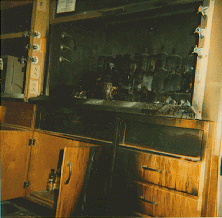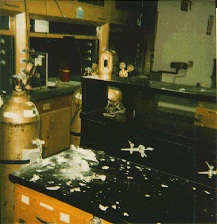 |
 |
|
In the spring 1997 semester of CHE 533 at the University of Kentucky, incompatible wastes were accidentally mixed resulting in a fire and explosion. It is believed that nitric acid and halogenated organic solvents were involved, but the exact cause may never be known. It is miraculous that there were no serious injuries from this explosion and fire. The student who last used the waste bottle reported that he saw some brown fumes coming from the waste bottle when he added his methylene chloride. He capped the bottle and walked away. A minute or two later it exploded. The explosion blew glass shrapnel across the laboratory. Students on the other side of the laboratory were hit with glass fragments, including at least one who reported that the glass bounced off his safety goggles. Thankfully, this student was following the rule you must wear your safety glasses at all times in the laboratory even if you aren't "doing anything." A fire immediately followed. The hood was completely engulfed in flames and the laboratory (approximately 2000 square feet) quickly filled with smoke so black, thick and acrid that one could not see across the lab. Fortunately, everyone was evacuated and there were no injuries. The fire was contained by faculty members who took a serious (and some would say extremely foolish) risk in battling this large and dangerous fire themselves [Note: see "Fire Extinguishers In The Chemical Laboratory" for tips about laboratory fires]. Serious injuries were avoided only because the student who normally works opposite that hood was not present at the moment of the explosion. Explosions of this nature can have an induction period ranging from one second to one hour or more. The last student to use this waste bottle was incredibly lucky.
|
 Prudent Practices in The Laboratory: Handling and Management of Chemical Hazards by the National Research Council is an excellent laboratory safety resource. |
 |
Figure 1. View of the fume hood where the accident occurred. Notice the large number of chemicals involved in the conflagration and the broken/melted chemical containers. Notice the large number which did not shatter or break, but could have detonated while the fire was being extinguished. |
 |
Figure 2. A second view of the fume hood involved in the fire. Notice the severe charring of the cabinetry. |
 |
Figure 3. Shrapnel damage. The hood involved in the fire is in the rear of the photo (notice the soot/char above the hood). The white material on this benchtop (3 hoods away) is the remains of the overhead fluorescent lights which were shattered by flying debris. Other glass fragments from the explosion traveled up to 10 meters from the hood; some were found imbedded up to 20 mm deep in the fume hood ductwork insulation. |
Alas, despite this article having been widely available since 1997, explosions of this nature continue to happen with alarming regularity. For example, a nearly identical incident occurred in 2015 at Texas Tech University and caused four injuries.

[Top of this page] [ILPI Lab Safety Home Page]
This page was last updated Monday, April 13, 2015 and is copyright 1996-2025 by Rob Toreki. All rights reserved.